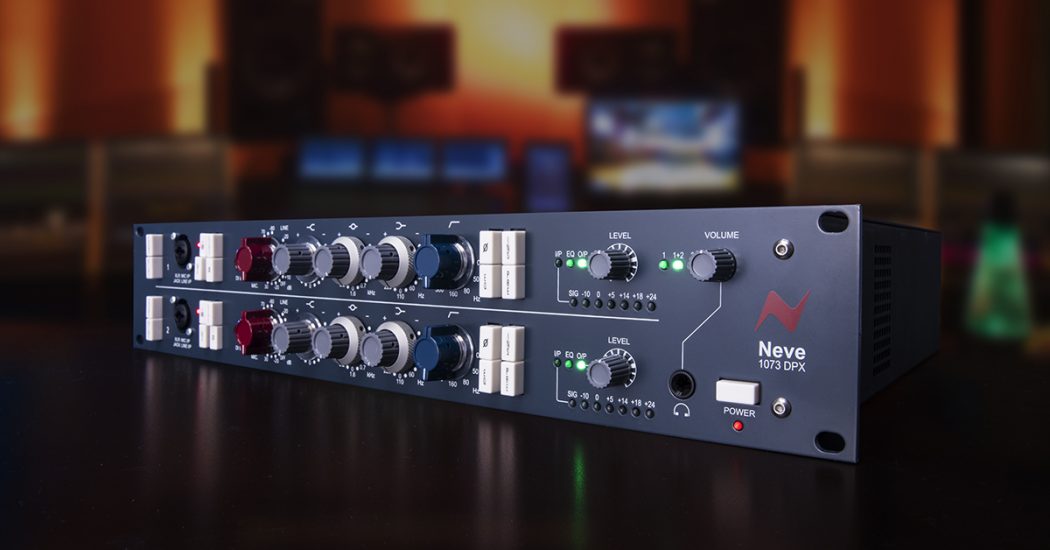
Few pieces of pro audio gear are as universally admired as the Neve 1073 preamp and EQ module. Generally regarded as the sound of classic rock, it has inspired countless hardware and software emulations, and, among professional engineers, it is often cited as a “desert island” preamp. So, what is it about the Neve 1073 that has kept it desirable for nearly half a century? Is it deserving of its perennial hype or simply the beneficiary of nostalgia and vintage-gear bias? Well, at Sweetwater, we believe that the Neve 1073 is indeed worthy of its reputation, but, before we get into why, let’s take a quick look at this iconic unit’s origin story.
London, 1970: Debut of the 1073
By the end of the 1960s, Neve Electronics, helmed by the young but not-yet-legendary designer Rupert Neve, had established itself as a force in the pro audio world, having built mixing consoles for Philips Records in London and Vanguard Records in New York as well as equipment for radio and television broadcasters around the world.
In 1970, Neve Electronics was commissioned to design a mixing console for Wessex Studios, a celebrated recording facility whose clients would eventually include the Rolling Stones, Queen, the Clash, and Sex Pistols. The console, a 24-channel Neve A88, was the first to include the Neve 1073 preamp and EQ modules.
King Crimson inaugurated Wessex Studios’ Neve A88 with their second full-length album, Lizard. At the time, Lizard received mixed reviews, owing primarily to its excursive compositions that pushed the bounds of experimental music. However, there was a consensus among musicians and music lovers that Lizard had set a new sonic benchmark, which was attributed in part to Wessex Studios’ Neve A88 and, more specifically, to the console’s 1073 preamps.
Marinair Transformers: The Sound of British Iron
When talking about 1970s Neve consoles that included the 1073 preamp and EQ, you’ll often hear the term “British Iron” used to describe the sound. The “iron” in that nickname refers to material used in the cores of the 1073’s input and output transformers. First manufactured by Marinair Radar according to Rupert Neve’s specifications, the 1073’s transformers are arguably most responsible for the module’s distinctive tone.
Like vacuum tubes and transistors, when transformers are overloaded with too much signal, they’ll saturate and create distortion. Pushed too hard, the results can be unpleasant. But, used judiciously, transformer saturation adds lively harmonic content, resulting in punchy mids and warm, deep lows. And, while all transformers will saturate, no two designs will saturate in quite the same way, which is part of the reason why the Neve 1073 has a sound like no other. But the Neve 1073’s Class A design also delivers a full and powerful sound when the transformer is not pushed hard, meaning you have a significant amount of control over how much you want to color a signal.
Eventually, Neve contracted with St. Ives Windings to also manufacture the 1073 transformers; that company fully took over manufacturing when Marinair ceased operations. Currently, Neve retains sole rights over the original 1073 transformer designs. Now produced by Carnhill in the St. Ives Windings factory, the 1073 transformers can be found in the current Neve 1073 range, including the Neve 1073 Original and the Neve 1073OPX 8-channel digitally controlled preamp system.
Formidable Tone Shaper: The 1073 EQ
Another aspect of the 1073 that has made it such a formidable studio tool is its straightforward but flexible EQ section. Comprising a highpass filter, high and low shelving EQs, and mid-frequency EQ, the 1073’s EQ section can be used to subtly or dramatically shape a signal and is considered to be among the most flattering EQs ever made.
The highpass filter ranges from 50Hz to 300Hz (stepped at 50Hz, 80Hz, 160Hz, 300Hz) and has a steep 18dB-per-octave slope, ideal for cutting out unnecessary low end and freeing up sonic real estate in your mix. The low shelving EQ offers four selections from 35Hz to 220Hz (stepped at these frequencies: 35Hz, 60Hz, 110Hz, 220Hz) either to add thump and impact to drums and bass guitar or to attenuate bass frequencies without eliminating them, which, in some cases, can have a more natural-sounding effect than the highpass filter.
The mid-frequency EQ is a +/-18dB peaking EQ, featuring a fixed Q and six selectable center frequencies ranging from 360Hz to 7.2kHz (center frequencies are multiples of 1kHz — 0.36kHz, 0.7kHz, 1.6kHz, 3.2kHz, 4.8kHz, and 7.2kHz). With boost or cut capabilities, you can use it to carve away mud in the lower mids or to add presence and punch to high mids. Engineers at Sweetwater are particularly fond of cranking up 7.2kHz on a snare drum to make it leap out of a mix — and we’ve found you can be aggressive without worrying about the 1073 becoming harsh or strident.
For adding sparkle and shine to vocals, acoustic instruments, and drum overheads, the 1073’s high shelving EQ is unmatched, capable of boosting 16dB above a fixed 12kHz. Conversely, you can cut up to 16dB above 12kHz, which is handy for taming fizzy amps, analog synths, and clicking drums.
The Neve 1073 Today: Modern Re-creations and Variants
As mentioned, the Neve 1073 has been relentlessly cloned, with numerous companies mimicking its fabled circuitry both in hardware and software forms. And many of these companies have been able to successfully capture the spirit of the 1073 even if they are not providing a one-to-one replica. However, if you’re looking for ultimate authenticity, Neve provides extremely faithful iterations along with some exciting variations that merge the 1073’s vintage vibe with functionality suited to modern hybrid recording setups.
If you’re interested in adding some 1073 flavor to your rig (you know you are!) but you aren’t sure which unit is right for you, then reach out to Sweetwater’s knowledgeable Sales Engineers at (800) 222-4700. They can help match you to a 1073 that will satisfy your sonic desires and workflow needs!






